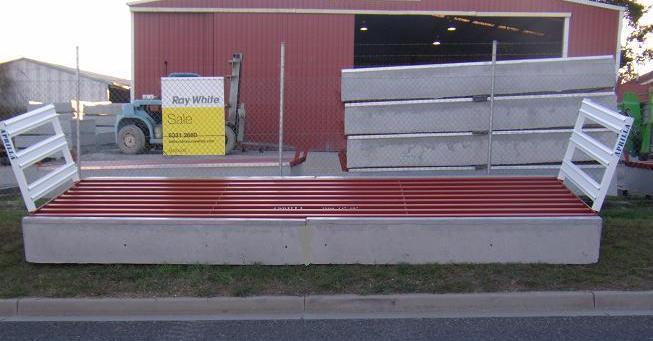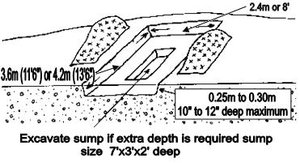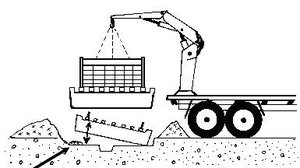Choose the best Possible Site
Every site is different when installing a stock grid. Try to allow for turning traffic including trucks, stock movement, the road itself (slope/shape/alignment), fencing and diverting the flow of water away from the raised grid.
- A gateway should be placed close by for stock transfer and steel track machinery.
- Potentially fast flowing water courses are best diverted through concrete pipes adjacent to sites to prevent undermining of the soil supporting the concrete bases; ie put a grid where the grid should go and put a pipe where a pipe should go; don’t try and combine the two.
- Allow for the overall width (including sides) between the posts and note that the sides are not attached directly in the corners of the grids (see picture below).
- If replacing old home made grids it is best and easiest to fill in the old hole and prepare a new site adjacent or in front of the old site.
- Aprilla grids are normally placed directly onto a firm soil surface, but in black or very soft wet sites (only) place a 300mm (12”) thick compacted gravel base.

Aprilla Grids can be installed one of two ways: above ground or in ground.
Above Ground

Above ground with the roadway built up. This is the best method but requires a considerable amount of fill and is not suitable for steeply sloping roadways.
In Ground 
Inground with hole depth only ½ of grid depth.
This is the easiest method as the fill removed from the hole is used to backfill the grid (then gravelled) forming a slight rise up to the grid,
so that during heavy rains water carrying silt will flow away from the grid and not into it.
If installed properly very little silt build up will occur.
Placement
Lift grids by steel section only, do not drag into position.
If your site is ready when your grid is delivered it can be beded into position. However, if your site is not ready when the grid is delivered, it will need to be placed near the site ready to be lifted into position.
1. Place the grid on the centre line of the road.
2. Align the grid with the direction of the road (not the fence line)
Look at it from both approaches from about 30m up and down the road.
Note: Steel Grids can be unbolted from the concrete base for hole cleaning if necessary.
Bedding in and Finishing off
- Tilt grids up on one edge by lifting with one chain attached to steel work on centre of opposite approach edge.
- Shovel about 50mm (2”) of soft fill (not sand) under opposite edge.
- Raise and lower the grid swiftly to evenly compact to required finished height.
- Repeat this procedure on the other approach edge ensuring the base is supported evenly along both approach edges and not sitting on any high spots. It is not essential for the end walls to be supported. Spirit levels are best left at home as the grids seem best set up to suit the lay of the roadway.
Back fill carefully: ensuring fill is not pushed into the grid pit section. If possible lay an old sheet of corrugated iron , or similar on top of the grid to prevent this.
Finish: approach road with good quality gravel ensuring final shape allows water to flow away from the grid and not into it.
Arrange fencing: galvanised mesh can be used to fill in the gaps between the angled grid sides and your fence posts.
Caution should be taken with horses, when grid is first installed at a new site make sure they know that the grid is there. Spray inside grid pit at least twice per year with Roundup or similar to keep the grid weed free and more stock proof .
Key Installation Points (for single grids on dirt shire, private and farm roads)
- Consider turning trucks; if possible allow at least 20m from sharp turns.
- Generally higher is better; to prevent silting, water should not run into the pit from the finished gravel road surface.
- Square the grid with the wheel tracks on the road, then adjust the fence to suit. Consider the grid as part of the road, not the fence line.
- Slope the grid with the slope of the road.
- Bed in concrete base properly. (see above).
- Remove one post in an existing gateway. Fit the grid then place a gate beside or near the grid for stock and steel track machinery.
- Do not drive steel drum road compaction rollers over grids. Use the gateway provided. Production grids are designed for rubber tyred vehicles and trucks only.
- Spray inside grid pit at least twice per year with Roundup or similar to keep the grid weed free and more stock proof .




